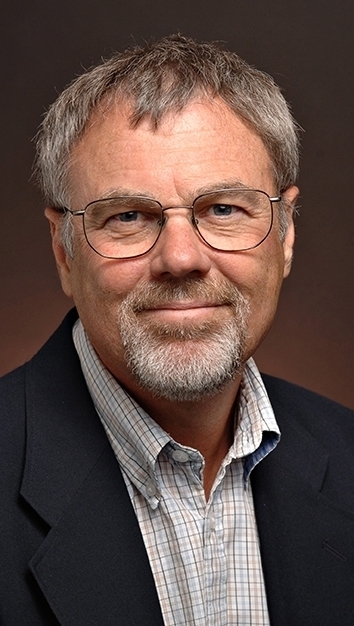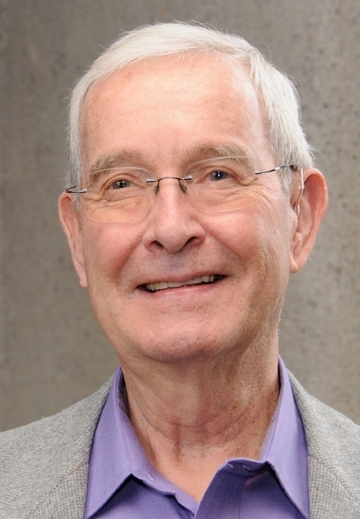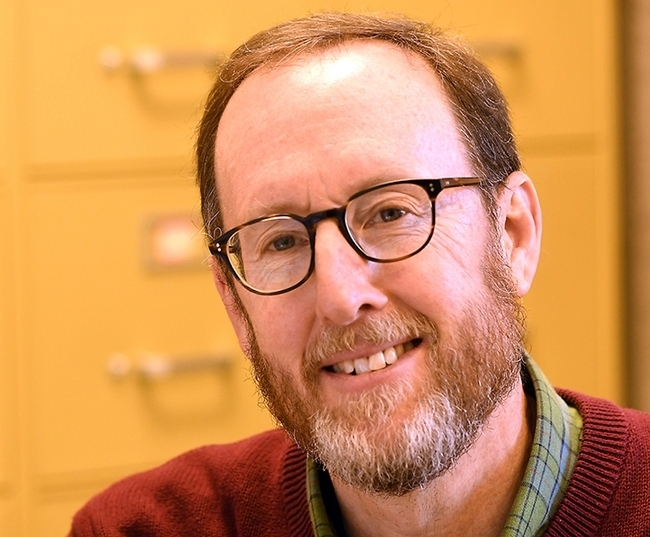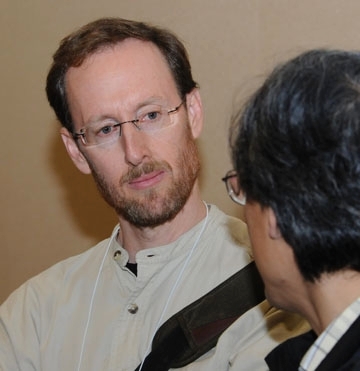- Author: Kathy Keatley Garvey

For the beekeepers that's easy. They dislike the pests known as "wax moths" and their larvae.
The female wax moths hang around the hives at night and when the opportunity arises, slip in to lay their eggs. If the colony is weak, this pest can take over.
The honey bee bible, The Hive and the Honey Bee (Dadant Publication), says the wax moth female "produces less than 300 eggs during her life span of 3 to 30 days, but a few lay as many as 2000 eggs. Mated females fly to beehives one to three hours after dark, enter, and lay eggs until they leave shortly before daylight."
The Hive and the Honey Bee authors relate that "the presence of the wax moth larvae usually signals a major problem such as queenlessness, an infectious disease, poisoning and starvation."
In his book, Honey Bee Biology (2023 Princeton University), bee scientist Brian Johnson, associate professor, UC Davis Department of Entomology and Nematology, touches on colony pests in addition to his indepth coverage of everything from molecular genetics, development, and physiology to neurobiology, behavior, and pollination biology.
Johnson writes in part: "The greater wax moth (Galleria mellonella) and the lesser wax moth (Achroia grisella) are old and well-known pests of honey bees. The female moth lays her eggs on the comb and the larvae consume the wax, pollen and honey. In nature, these pests are mainly a threat to weak colonies, as strong colonies can kill their larvae." He goes on to mention that beekeepers who inadequately store large amounts of wax combs may be subject to wax moth infestations. He recommends air tight storage and the use of mothballs.
The larvae are not always unwanted. They've been introduced as an alternative model to study microbial infections.
So, in keeping with National Moth Week, the Bohart Museum of Entomology is hosting its annual Moth Night from 7 to 11 p.m. on Saturday, July 20 at its headquarters in Room 1124 of the Academic Surge Building, 455Crocker Lane, UC Davis. Inside, Jeff Smith, curator of the Bohart's Lepidoptera collection, and his colleagues will be displaying moth specimens and answering questions. Outside, Bohart research associate John "Moth Man" De Benedictus will set up a blacklighting display, complete with white sheet and a UV light to attract moths and other night-flying insects.
The open house is free and family friendly. Also free: hot chocolate and cookies, according to Tabatha Yang, education and outreach coordinator.
Founded in 1946, the Bohart Museum is the home of a global collection of eight million insect specimens. It also features a petting zoo (including Madagascar hissing cockroaches, walking sticks and tarantulas) and a gift shop stocked with insect-themed t-shirts, hoodies, books, posters, jewelry and more. The museum is directed by Professor Jason Bond, the Evert and Marion Schlinger Endowed Chair, UC Davis Department of Entomology and Nematology, and associate dean, Agricultural Sciences, UC Davis College of Agricultural and Environmental Sciences.



- Author: Kathy Keatley Garvey
247 years!
The seven faculty members honored at the UC Davis Department of Entomology and Nematology's recent retirement luncheon amassed an amazing 247 years of service:
- UC Davis distinguished professor James Carey, 44 years, faculty member since 1980. He retired in June.
- UC Davis distinguished professor Richard Karban, 42 years, faculty member since 1982. He retired in June.
- UC Davis distinguished professor emerita Lynn Kimsey, 35 years, faculty member since 1989. She retired Feb. 1, 2024.
- Robert Kimsey, adjunct professor, 35 years, faculty member since 1989. He retired in June
- UC Davis distinguished professor Jay Rosenheim, 34 years, faculty member since 1990. He retired in June.
- UC Davis distinguished professor Diane Ullman, 29 years, faculty member since 1995. She retired in June.
- Sharon Lawler, professor emerita, 28 years, faculty member since 1995. She retired in January 2023.
Read about them on our UC Davis Entomology and Nematology website, with links to individual stories. You may have interacted with one or more of them through their research, teaching or public service.
As molecular geneticist and physiologist Joanna Chiu, professor and chair of the department, said prior to the retirement luncheon: “Our retiring faculty will leave behind some very big shoes to fill. “They have set the bar very high for all of us with their passion to lifelong scientific exploration, perseverance to achieve intellectual and mentoring excellence, and dedication to the department, UC Davis, and external stakeholders. We are so proud to call them colleagues and mentors and they will no doubt continue to inspire us to carry on their legacy. It is with our most sincere appreciation that we wish all of them the best in their new endeavors and adventures in this next chapter of their lives."
247 years of service!







- Author: Kathy Keatley Garvey
Thought for the day...
Every time we see a honey bee "posing perfectly" on a Gaillardia, commonly known as blanket flower, we think of a quote by internationally known honey bee geneticist, Robert E. Page Jr., a UC Davis doctoral alumnus and professor and chair emeritus of the UC Davis Department of Entomology (now the Department of Entomology and Nematology):
"The impact of bees on our world is immeasurable. Bees are responsible for the evolution of the vast array of brightly-colored flowers and for engineering the niches of multitudes of plants, animals, and microbes. They've painted our landscapes with flowers through their pollination activities and have evolved the most complex societies to aid their exploitation of the environment."
That's a passage from his book, The Art of the Bee.It's also featured on his YouTube Channel, https://www.youtube.com/@artofthebee.
Rob obtained his doctorate in entomology in 1980 from UC Davis; joined the UC Davis faculty in 1989; and chaired the Department of Entomology from 1999 to 2004. After retiring from UC Davis in 2004, he accepted an appointment at Arizona State University (ASU) as founding director of the School of Life Sciences. He served as dean of the College of Liberal Arts and Sciences, 2011-2013, and provost of ASU from 2013-2015. He is now emeritus. He was recently featured in Legends, American Entomologist. (See UC Davis Department of Entomology website)
Why did Page create the free and accessible-to-all YouTube Channel? Because that's what Alexander von Humboldt (1769-1859), known as a German geographer, naturalist, explorer, and proponent of Romantic philosophy and science, would have done.
It's about making science understandable.
Check out Page's YouTube channel, including:
- Landscape Artists
- Environmental Engineers
- The Social Contract
- Superorganisms
- How to Make a Superorganism
- Song of the Queen

- Author: Kathy Keatley Garvey

Titled "Robert E. Page, Jr.: The Spirit of the Bee," it's a great article chronicling his life, his love of bees, and his massive number of achievements. Rice captured it well.
Rob, a native of Bakersfield and now 74, received his doctorate in 1980 from UC Davis, studying with major professor Norman Gary and doctoral research mentor Harry H. Laidlaw Jr. He advanced to professor and chair of the Department of Entomology (now the Department of Entomology and Nematology). A second career emerged when Arizona State University (ASU) recruited him.
Today Page holds the titles of ASU University Provost Emeritus and Regents Professor Emeritus as well as UC Davis Distinguished Emeritus Professor and Emeritus Chair of the UC Davis Entomology Department.
Page is known for his research on honey bee behavior and population genetics, particularly the evolution of complex social behavior. One of his most salient contributions to science was to construct the first genomic map of the honey bee, which sparked a variety of pioneering contributions not only to insect biology but to genetics at large.
Page pioneered the use of modern techniques to study the genetic basis of social behavior evolution in honey bees and other social insects. He was the first to employ molecular markers to study polyandry and patterns of sperm use in honey bees. He provided the first quantitative demonstration of low genetic relatedness in a highly eusocial species.
He is "arguably the most influential honey bee biologist of the past 30 years," his peers say.
At UC Davis, Page worked closely with Laidlaw. Together they published many significant research papers and the landmark book, “Queen Rearing and Bee Breeding” (Wicwas Press, 1998), considered the most important resource book for honey bee genetics, breeding, and queen rearing.
For 24 years, from 1989 to 2015, Page maintained a UC Davis honey bee-breeding program, managed by bee breeder-geneticist Kim Fondrk. Their contributions include discovering a link between social behavior and maternal traits in bees. Their work was featured in a cover story in the journal Nature. In all, Nature featured his work on four covers from work mostly done at UC Davis.
Page authored two books: The Spirit of the Hive: The Mechanisms of Social Evolution (Harvard University Press, 2013) and the Art of the Bee: Shaping the Environment from Landscapes to Societies (Oxford University Press, 2020). In 2023, he launched a publicly accessible YouTube Channel, https://youtube.com/@artofthebee.

When Rice asked Page "Who was the most influential person in your education," Page replied: "Today, all my research approaches, the way I thought about things, everything I did I can point back to four people. Norm Gary taught me the importance of knowing behavior and having good behavioral assays. He was superb at it. Nobody knows better what bees will do than Norm Gary, but he doesn't care much about why they do it. Which then brings me to my training in evolution from Tim Prout, who was an evolutionary biologist and population geneticist. He taught me population genetics, which I use to develop a population way of thinking about the work that I do. Harry Laidlaw taught me the value of breeding and the value of attention to detail. When we wrote papers together, we went over every word. Harry believed that every word had to be there for a reason. Every word had to be right. Robert A. Metcalf, an incredible guy, really turned me on to social insects, and got me interested in using molecular and biochemical markers. Everything I did for the rest of my career came from those four people."
This week we asked Gary, now 90, what it was like to have Rob as his graduate student.
In a June 17th email, Gary wrote: “When I first met Rob Page at the beginning of his graduate studies, I was immediately impressed that he was a very exceptional student in all respects! He was enthusiastic about insect behavior, especially honey bee behavior. I became his major professor. His fascination with behavior soon evolved into behavioral genetics. Consequently, I encouraged him to conduct his graduate research under the direction of Harry Laidlaw whose research program focused on honey bee genetics."
"Rob and I shared several bee research projects, one of which involved research on honey bees to determine if insects would be adversely affected by exposure to microwaves from solar power satellites that were under consideration as a future source of energy for mankind. Rob excelled in all activities. His enthusiasm was contagious! He richly deserves the many rewards he has received during his career, especially for his superior skills in research, teaching, and leadership in every facet of the academic world.”
You may know Norm Gary as not only a professor, scientist, musician, and author but one of the world's most incredible professional bee wranglers. He used to wear full-body bee suits and play the b-flat clarinet. (See Bug Squad blog of Nov. 30, 2016). He once trained bees to fly into his mouth to collect food from a small sponge saturated with his patented artificial nectar. He holds the Guinness World record (109 bees inside his closed mouth for 10 seconds) for the stunt.
It's all about The Bees for Rob Page and Norm Gary.
It's always been about The Bees.


- Author: Kathy Keatley Garvey

I posted that on May 21, 2009 when Jay--now UC Davis Distinguished Professor Jay Rosenheim--won the first of many teaching awards spearheaded by his students.
He'll soon be UC Davis distinguished professor emeritus. He's retiring at the end of June after 34 years with the Department of Entomology and Nematology (ENT).
The department won't be the same without him.
Rosenheim specializes in insect ecology, integrated pest management, and biological control, and the use of farmer-generated data to enhance pest and crop management ('Ecoinformatics'). He is internationally known for his research on the ecology of insect parasitoids and predators, insect reproductive behavior, and the application of big data, or ecoinformatics, methods in agricultural entomology.
And he was among the seven retiring or newly retired ENT faculty members honored on June 11 at a department-sponsored event at UC Davis Alumni Center.
Professor Louie Yang said it well at the event.
"I've known him for 24 of those years and having seen just a little bit of how much he has done for students, colleagues, and the university in each of those years, it is deeply humbling to reflect upon his cumulative career-long contribution to science and mentorship."
"I've come to see that there are many ways to be a professor," Yang continued. "Jay's way has long been characterized by creative scholarly achievements, thoughtful and intentional contributions to agriculture, an intuitive feel for his organisms and a natural intuition for the quantitative side of ecology. I've also had a chance to witness and benefit from Jay's commitment to mentorship up close. Jay has provided mentorship to students and faculty alike, and I've benefited from both. His mentorship is characterized by good judgment and empathy; he is quick to forgive mistakes and genuine in celebrating your successes. On our campus, he's provided leadership of a quiet doing kind, often working behind the scenes to make important things happen and to provide a calming and moderating influence in challenging times."

Yang concluded with "I will sorely miss having Jay as a colleague. But I want to end with a heartfelt thanks. Thanks for all you've done for us over the many years, and for passing the baton. We wish you all the best on the road ahead."
A native of Yorktown, N.Y, young Jay developed an interest in biology while exploring the vernal pools behind his Hudson River Valley home. As an undergraduate at UC Davis, he initially majored in physics. "On a lark" he enrolled in Professor Harry Kaya's Entomology 100 course in 1981. The professor inspired him, the class enthralled him, and insects captivated him.
Rosenheim's career has not only led to his being elected a Fellow of the Entomological Society of America (ESA) and a Fellow of the American Association for the Advancement of Science, but recipient of teaching awards from the Associated Students of UC Davis and the UC Davis Academic Senate; the Distinguished Student Mentoring Award from ESA's Pacific Branch and the campuswide Graduate Program Advising and Mentoring Award.
Rosenheim co-founded and co-directs the campuswide Research Scholars Program in Insect Biology (RSPIB) with Professors Joanna Chiu (now chair of the department) and Yang. The program aims to provide "undergraduates with a closely-mentored research experience in biology," according to the website. "Because insects can be used as model systems to explore virtually any area of biology (population biology; behavior and ecology; biodiversity and evolutionary ecology; agroecology; genetics and molecular biology; biochemistry and physiology; cell biology), faculty in the program can provide research opportunities across the full sweep of biology. The program's goal is to provide academically strong and highly motivated undergraduates with a multi-year research experience that cultivates skills that will prepare them for a career in biological research."
Rosenheim is the kind of professor who ignites, inspires and supports you. He recently reflected on his role: "The job of a professor is quite diverse, and quite rewarding in different ways. Teaching in a classroom provides instant gratification, as you see the light of understanding and excitement shining in students' eyes as they explore and grasp new concepts. Research in the laboratory provides instead delayed gratification, where long periods of hard work--sometimes years--may pass before questions are answered and one feels the satisfaction of pushing forward the margins of scientific understanding."
"But, perhaps the most lasting sense of accomplishment comes from mentoring graduate students," Rosenheim related. "Building relationships with graduate students, watching them grow in their skills and confidence and, finally, seeing them establish themselves in their careers, provides the kind of reward that is similar in some ways to the happiness that parents derive from their children. And the relationships never end--they are bonds that last a lifetime. I think the key to effective mentorship is to place the student's welfare at the top of one's priority list. So, drafts of papers should be returned promptly with constructive suggestions, and not allowed to languish in a long queue of manuscripts waiting for reviews--more senior colleagues can wait, if someone needs to wait."
We owe a debt of gratitude to UC Davis Distinguished Professor Jay Rosenheim, exemplary teacher, mentor and researcher, and wish him well in his retirement.



